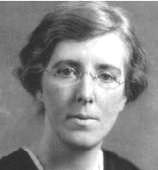
Kathleen Clarke
Public opinion, doubtful at first, changed to widespread sympathy in the aftermath of the 1916 Rising as stories circulated and were vigorously debated about the executed leaders, the prisoners, the victims and the behaviour of the British authorities and military.
Over the next few years several women and men published accounts of their own experiences. There were thousands of stories about people less well-known and many of these were recorded also. Complex emotions were expressed in literature. The poet WB Yeats, though critical of the whole episode, famously concluded that as a result of the Rising, 'A terrible beauty is born.'
Attention focused on women also, especially on bereaved widows, mothers and sisters and on Constance Markievicz now imprisoned as a criminal in England. Mrs Pearse had lost two sons in the executions and Kathleen Clarke a husband and brother. Grace Gifford had married Joseph Plunkett in Kilmainham Jail chapel the night before his execution and her sister Muriel had lost her husband, Thomas McDonagh. Maud Gonne, living in France, was now the widow of John McBride from whom she had been estranged for years. Suffragist Hanna Sheehy Skeffington was also widowed. Her husband Francis having organised a Citizen's Defence Force to control looting, was arrested, witnessed acts of violence by British soldiers and was shot by firing-squad without trial on the orders of a British officer.
| Soon after her husband's execution, Kathleen Clarke began a fund to support the dependants of imprisoned Volunteers. Women were also active in the work of propaganda, as there was an urgent need to explain the Rising and the political issues involved in the project of an Irish Republic. Women held meetings to demand the release of the prisoners; they issued posters and postcards, had prayers and masses said and they made collections. |  Kathleen Clarke |
They toured America giving lectures and collecting funds. Min Ryan went as an envoy from Cumann na mBan. Margaret Skinnider, Nellie Gifford, Nora Connolly and others went also. Hanna Sheehy Skeffington went to draw American attention to the fact that the murderers of her husband had not been brought to account as well as to raise American awareness of the situation in Ireland. As a suffragist, she had denounced Cumann na mBan for their 'slavish attitude' to men in the past but by now Cumann na mBan women were becoming more independent and self-reliant and Hanna, who had nationalist sympathies herself, drew somewhat closer to them. Between January 1917 and June 1918 she addressed over 250 meetings in America, including a crowd of 3,000 in New York and presented a petition from Cumann na mBan to President Wilson.
At the historic Sinn Féin convention of 1917 where the aims of the organisation were redirected towards 'securing the international recognition of Ireland as an independent Irish Republic', four women were elected to the executive and Jennie Wyse Power was later co-opted. Cumann na mBan at their own convention restated their aims to include the 'arming and equipping of the men and women of Ireland.'
All the prisoners were released by June 1917 and Constance Markievicz was driven through the streets of Dublin on a float decked with flowers and flags.
| ... in the midst of a long procession, with banner after banner and brass band after brass band; with riders on horseback; with running boys waving branches; with lumbering floats drawn by slow-footed good-natured Clydesdale horses; with trade-guilds carrying emblems; with public notabilities in uniform; with ragged urchins from the slums - a glad and multitudinous company, laughing, shouting, singing. Ella Young, Flowering dusk, London 1945, p.133 quoted in Margaret Ward, In their own voice: women and Irish nationalism, Cork, 1995, p.82. |